Every session, legislators consider thousands of policy proposals, covering a wide range of issues, under severe time constraints. With such a workload, it is simply not feasible to expect any individual to develop detailed knowledge about many proposals on the agenda. As a result, legislators are often described as poorly informed about public policy (Krehbiel Reference Krehbiel1991; Mill Reference Mill1861; Treadway Reference Treadway1938). Nevertheless, legislators are expected to support bills that are popular with constituents and oppose those that are unpopular (Canes-Wrone, Brady, and Cogan Reference Canes-Wrone, Brady and Cogan2002). So how do uninformed legislators take the right positions?
Legislators can overcome individual information constraints by relying on cues from their peers (Box-Steffensmeier, Ryan, and Sokhey Reference Box-Steffensmeier, Ryan and Sokhey2015; Kingdon Reference Kingdon1973; Masket Reference Masket2008; Matthews and Stimson Reference Matthews and Stimson1975). Legislators often give advice to one another about which position they should take. This guidance may be formal, such as an instruction from a party leader, or informal, such as one legislator observing the vote of another. Cues effectively allow the decision-maker to take her fully-informed position without actually becoming fully-informed about the issue. Legislators report that cue-taking influences between 40% (Kingdon Reference Kingdon1973) and 75% (Matthews and Stimson Reference Matthews and Stimson1975) of their votes. Observational studies find cue-taking affects about 10% of votes (Masket Reference Masket2008). It seems clear that cue-taking is an important factor in legislative decision-making.
Randomization-based research designs have found less evidence of cue-taking. Rogowski and Sinclair (Reference Rogowski and Sinclair2012) leverage the random assignment of office space in Congress to estimate the causal effect of office proximity on position-taking. Coppock (Reference Coppock2014, Reference Coppock2016) estimates cue-taking between ideologically-similar legislators exposed to a randomized information treatment by Butler and Nickerson (Reference Butler and Nickerson2011). Unlike the survey or observational studies, neither experimental study finds consequential cue-taking.
These contradictory findings illustrate how much we have yet to learn about cue-taking. Whom do legislators look to for cues? Perhaps deskmates (Masket Reference Masket2008) and friends (Matthews and Stimson Reference Matthews and Stimson1975) share information, but not office neighbors (Rogowski and Sinclair Reference Rogowski and Sinclair2012) or ideologically-similar legislators (Coppock Reference Coppock2014). What happens if a typical cue-giver is unavailable? Legislators may be able to replace one cue-giver with another. Did cue-taking decline between the early study of Matthews and Stimson and the later studies of Rogowski and Sinclair and Coppock?
This study revisits this classic literature on cue-taking with a new empirical approach. Previous studies may have failed to observe cue-taking either because they looked for it in the wrong place—between legislators who do not share information with one another—or lacked sufficient power to detect effects. This paper utilizes a large dataset from two legislative field experiments to estimate cue-taking within naturally-occurring legislative networks. Specifically, it explores cue-taking between legislators who share office suites. The experiments randomly provided legislators with technical policy briefings concerning real bills on the legislative agenda. Briefings occurred in one-on-one meetings with directly treated legislators. Briefings substantially affected cosponsorship by those subjects. The primary research question of this paper is whether directly treated legislators provided influential cues to untreated peers in their office suites.
Unlike research designs that rely on randomly-assigned communication networks or endogenous shocks to legislators’ information, this design examines the diffusion of a randomly-assigned, but realistic, information treatment across legislators’ self-selected communication networks. In this way, the paper combines the rigorous identification approach of Rogowski and Sinclair (Reference Rogowski and Sinclair2012) with a focus on the types of self-selected communication networks that Matthews and Stimson (Reference Matthews and Stimson1975) and Kingdon (Reference Kingdon1973) found to be characteristic of cue-taking. The result is a novel test that resolves discrepancies about the scope of legislative cue-taking and provides evidence on its timing, mechanisms, and complementarity with other pieces of information.
This study contributes to the literature on cue-taking in at least five ways: (1) by illustrating that the causal effect of cue-taking can be estimated through an experiment that models treatment contagion in endogenous networks; (2) by providing precisely-estimated cue-taking effects due to the large dataset employed; (3) by estimating heterogeneous treatment effects by bill; (4) by exploring the timing of cue-taking; and (5) by demonstrating that cue-taking complements other sources of policy expertise in legislatures.
CUE-TAKING IN LEGISLATIVE NETWORKS
Cue-taking is a shortcut by which imperfectly informed decision-makers look to other individuals for guidance and advice. Matthews and Stimson define cues as “any communication, verbal or nonverbal, intended or unintended that is employed by the cue-taker as a prescription for his vote” (Reference Matthews and Stimson1975, 51). Committee reports, informal conversations, explicit recommendations, and even cosponsorships or roll call votes can qualify as cues. This broad conception of communications that may be used as cues has led to a diverse empirical literature on cue-taking.
Early studies looked for evidence of cue-taking by directly asking legislators how they made voting decisions. Kingdon (Reference Kingdon1973) and Matthews and Stimson (Reference Matthews and Stimson1975) asked legislators where they looked for advice and how often they relied on decision-making shortcuts. Legislators recounted that they frequently looked to peers to decide how to vote. Up to 75% (Matthews and Stimson Reference Matthews and Stimson1975) of votes were reported to be based on cues from fellow legislators.
This approach examines cue-taking through endogenous relationship networks. It searches for cue-taking where it is most likely to be found, between legislators who self-report that they share information with one another. The problem with studying cue-taking in these naturally-occurring relationship networks is separating the causal influence of cues from the self-selection that characterizes the network’s formation (Shalizi and Thomas Reference Shalizi and Thomas2011; see Wojcik Reference Wojcik2018 for a discussion of causality in legislative voting networks). Legislators choose which peers to associate with and take cues from: even if we observe that legislators who share cues vote more similarly, we cannot differentiate the causal influence of cues from homophily or other decision-making factors correlated with the communication network.
One solution to self-selection in endogenous networks is to look for exogenous relationship networks. Masket (Reference Masket2008) and Rogowski and Sinclair (Reference Rogowski and Sinclair2012) examine cue-taking between legislators who are placed into close contact by an outside factor. Masket studies California state legislators who are assigned to shared desks by the chamber leader. Rogowski and Sinclair examine members of Congress whose office proximity is determined by the congressional office lottery. Masket finds modest evidence of cue-taking, while Rogowski and Sinclair observe none.
Exogenous cue-taking networks avoid the pathologies of self-selected networks, but at the cost of assuming that cue-taking relationships can be created exogenously. Legislators consider many factors when choosing a cue-giver. They weigh a legislator’s policy expertise, ideology, personal background, and personality. Assigning legislators to share a desk or office building is unlikely to replace these considerations. It is not clear why we would expect significant cue-taking to occur between legislators who are randomly assigned to interact with one another.Footnote 1 Whether exogenously-created relationship networks can influence voting or other forms of legislative decision-making is an important empirical question. However, in an ideal world, we would study cue-taking through the relationships that naturally form in legislatures. But how can we detect cue-taking through these relationships when endogenous networks are characterized by self-selection?
A new approach to this problem is to combine social network analysis with randomization-based research designs. Rather than estimating the effect of exogenous networks, we can estimate the effect of a randomly-assigned treatment that spreads across an endogenous network (Bowers, Frederickson, and Panagopoulos Reference Bowers, Fredrickson and Panagopoulos2013; Coppock Reference Coppock2014; Sinclair, McConnell, and Green Reference Sinclair, McConnell and Green2012).Footnote 2 It is well-known that randomly assigning a treatment identifies its causal effect on the subject who receives it. Random assignment also identifies the contagion effect of the treatment on subjects who are exposed to it through a peer in a network.
There is a trade-off to be made in order to study naturally-occurring networks: we cannot study naturally-occurring information. One of the independent variables—either the network or the information—should be exogenous, and ideally randomly-assigned, to support causal interpretations of cue-taking’s role in position-taking. Although in this study information is exogenous, the information treatments were created to be realistic and comparable to other research reports available to legislators. Informational content was obtained directly from bill sponsors themselves, and information was provided to subjects by a legislative staffer in an unobtrusive, ordinary course-of-business manner. In this way, the study examines naturally-occurring networks and authentic information treatments. This realism in both network and treatment supports both the internal and external validity of the research design.
ESTIMATING CUE-TAKING WITH EXPERIMENTS
In the past decade, experimental research designs have gained popularity in legislative studies. Among many other interesting works, foundational experiments have examined the causal effect of information on constituency service and home style (Butler and Broockman Reference Butler and Broockman2011; Butler, Karpowitz, and Pope Reference Butler, Karpowitz and Pope2012); constituents’ access to legislators (Kalla and Broockman Reference Kalla and Broockman2015); and legislators’ voting behavior (Bergan Reference Bergan2009; Butler and Nickerson Reference Butler and Nickerson2011). As much as these studies have discovered about legislative behavior, they have largely ignored cue-taking or interpersonal influence between legislators (cf. Coppock Reference Coppock2014).
At first, experiments might seem like an odd method for studying cue-taking. Experiments often rely on the “stable unit treatment value assumption” (SUTVA), also known as “non-interference.” Non-interference declares that each subject’s potential outcomes are unaffected by the treatment status of other subjects. Treatment contagion, or spillover, violates the assumption. Non-interference is typically necessary to identify the causal effect of a treatment on individual behavior. If interference occurs in unknown ways, estimating treatment effects becomes practically impossible.
Interference can be an opportunity, not just a nuisance, for the study of cue-taking. Treatment effects are identified not only for the direct treatment, but also for treatment spillovers as long as the spillover network is known. What constitutes the right spillover network is an open question and one that depends on the experimental context.
The researcher can define a broad network of spillover in which contagion is allowed between many, perhaps even all, subjects (Bowers, Frederickson, and Panagopoulos Reference Bowers, Fredrickson and Panagopoulos2013; Coppock Reference Coppock2014). This approach is appealing because it considerably relaxes the non-interference assumption. However, it requires strong modeling assumptions to aggregate influence from many peers into a single dosage of treatment exposure. Nevertheless, this contagion network makes sense in contexts where individuals interact with and influence many others, such as in the transmission of contagious diseases or gossip.
Another approach is to allow a limited degree of interference within narrow subgroups of subjects, but not across them. For example, Nickerson (Reference Nickerson2008) and Foos and de Rooij (Reference Foos and de Rooij2017) estimate contagion of a get-out-the-vote treatment within households. Both assume that contagion may occur within, but not between, households. This model makes more sense when individuals’ interactions are limited to close relations.
In deciding which approach is appropriate, the researcher must decide whether contagion is likely to be more diffuse or concentrated in a given context. This study examines contagion between the legislative equivalent of households: offices. In the state where the experiments were conducted, a majority of legislators share office suites. Although party leaders and many committee chairs occupy one-person office suites, multi-person suites are the norm. Even some senior legislators such as committee and subcommittee chairs share suites. In these suites, assistants sit in a common anteroom beyond which each legislator has a private office.
Legislators have wide latitude in choosing their offices, such that office assignment is far from random. As a result, officemates tend to represent similar, often neighboring districts, and to be friends. All office suites consist of co-partisans. In this case, self-selection of the network is a virtue. Sharing offices may not cause legislators to share information, but legislators who share information likely self-select into shared suites.
Let us define the potential outcomes that can result if treatment diffuses within offices. Legislators’ potential outcomes are a function of their own and their officemate’s treatment statuses, Y i(d i, d ¬i), where Y i represents a behavior of interest by legislator i; d i represents whether legislator i is assigned to receive a treatment; and d ¬i indicates whether the legislator’s officemate is assigned to a treatment.Footnote 3 To fix ideas and preview the study to come, a legislator’s cosponsorship decision may be the result of whether she receives a policy briefing directly and whether her officemate receives a briefing.
Figure 1 illustrates direct (T) and secondary (S) treatment effects between two subjects when one individual receives direct treatment (Foos and de Rooij Reference Foos and de Rooij2017; Nickerson Reference Nickerson2008). Secondary treatment equates to cue-taking. It may result from conscious information-sharing or from legislators’ mimicking the positions of their peers. The content of the secondary treatment cannot be strictly defined, but with random assignment and the right spillover model, we are sure that secondary treatment is the portion of the briefing effect transmitted between legislators by cues.
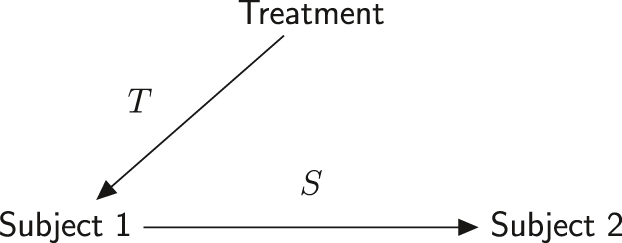
FIGURE 1. Spillover in a Two-Person Setting
Assigning both subjects in a pair to direct treatment introduces new causal effects. In Figure 2, each effect (T and S) is conditioned by whether the other effect is also present. T S=0 indicates an individual who is assigned to direct but not secondary treatment, and T S=1 an individual who is assigned to both. This raises a complication. Are direct effects independent of secondary effects? That is, does T S=0 = T S=1? Does S T=0 = S T=1? Simply put, we do not know, and the strong assumption that effects are independent is typically unwarranted in social science applications (Aronow and Samii Reference Aronow and Samii2017; Bowers, Frederickson, and Panagopoulos Reference Bowers, Fredrickson and Panagopoulos2013; Hudgens and Halloran Reference Hudgens and Halloran2008). As a result, we cannot separately estimate S T=1 or T S=1. We can, however, estimate the combined effect of T S=1 + S T=1, that is, the joint effect of a briefing and cue on behavior.
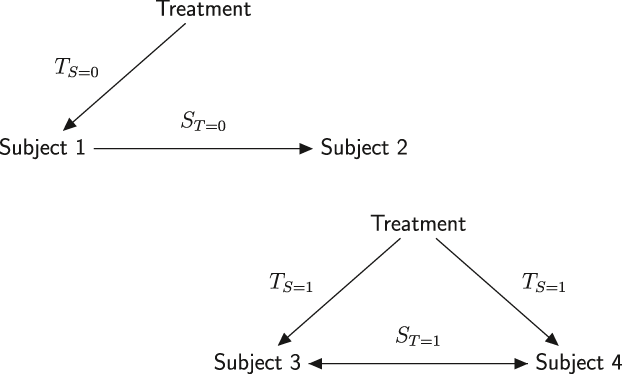
FIGURE 2. Spillover in a Two-Person Setting with Treatment-by-Treatment Interaction
Table 1 demonstrates how direct (T S=0), secondary (S T=0), and combined (T S=1 + S T=1) treatment effects can be estimated from an experiment that allows zero, one, or two legislators per pair to be assigned to direct treatment. The rows indicate whether a subject is hypothetically assigned to treatment herself (D i) and the columns indicate whether her officemate is assigned to treatment (D ¬i). There are four potential combinations of treatment assignment in this 2 × 2 design. The cells marked (1)–(4) indicate the expected outcome of our variable of interest Y in each combination of direct and secondary treatment assignment.
TABLE 1. Estimating Direct, Secondary, and Combined Effects

Three treatment effects are identified in this design. The direct effect of treatment is identified by taking the difference in means between legislators assigned only to direct treatment (3) from those assigned to neither direct nor secondary treatment (1). The effects of secondary treatment (2) and combined treatments (4) are similarly identified by taking the difference in means between their respective average outcomes and those in the untreated group (1). Note that attempting to estimate other effects, such as the effect of direct treatment conditional on being assigned to spillover (T S=1), requires untestable assumptions about the independence of some treatment effects. Taking the difference ![]() ${\mathbb{E}}\left[ {{Y_i}|{d_i} = 1,{d_{\neg i}} = 1} \right] - {\mathbb{E}}\left[ {{Y_i}|{d_i} = 0,{d_{\neg i}} = 1} \right]$ to estimate the effect of direct treatment conditional on assignment to spillover implicitly assumes S T=1 = S T=0.
${\mathbb{E}}\left[ {{Y_i}|{d_i} = 1,{d_{\neg i}} = 1} \right] - {\mathbb{E}}\left[ {{Y_i}|{d_i} = 0,{d_{\neg i}} = 1} \right]$ to estimate the effect of direct treatment conditional on assignment to spillover implicitly assumes S T=1 = S T=0.
One additional quantity of interest is relevant to studies of cue-taking. The contagion rate (α) can be estimated as the ratio of secondary to direct treatment effects ![]() $\left( {{{{S_{T = 0}}} \over {{T_{S = 0}}}}} \right)$ (Nickerson Reference Nickerson2008). The contagion rate compares the magnitude of the indirect treatment to that of the direct treatment. For studies of cue-taking, it is the relative change in the position of a cue-taker compared to the change in the position of a cue-giver.Footnote 4
$\left( {{{{S_{T = 0}}} \over {{T_{S = 0}}}}} \right)$ (Nickerson Reference Nickerson2008). The contagion rate compares the magnitude of the indirect treatment to that of the direct treatment. For studies of cue-taking, it is the relative change in the position of a cue-taker compared to the change in the position of a cue-giver.Footnote 4
With these estimands defined, we can pose several hypotheses regarding cue-taking:
H1: Cue-taking affects position-taking. α > 0.
Direct and secondary effects may be zero for any given experiment; an experimental intervention need not be influential. But conditional on an influential treatment being provided, legislators will transmit its effects to peers. The contagion rate will be positive since cue-takers adopt the positions of their cue-givers. Their behavior changes in the same direction as their cue-giver’s, not counter to it. The larger the contagion rate, the more influential is cue-taking.
H2: Exposing a legislator to a cue will exert no additional effect if the legislator has already received a direct briefing. TS=1 + ST=1 = TS=0.
H3: Briefing a legislator who has been exposed to a cue will exert no additional effect. TS=1 + ST=1 = ST=0.
Taken together, H 2 and H 3 describe a world in which briefings and cues are perfect substitutes, or one in which each treatment leads legislators to their fully-informed positions. It is possible that one of the two mechanisms leads to fully-informed positions. A more modest proposition is that cues and briefings are imperfect substitutes. In that case, the combined effects of direct and secondary treatments would be smaller than the sum of their individual effects (T S=1 + S T=1 < T S=0 + S T=0).
H4: The combined effects of briefings and cues will be greater than the sum of their individual effects. TS=1 + ST=1 > TS=0 + ST=0.
H 4 describes briefings and cue-taking as complements. Repeated messaging may magnify the effectiveness of individual messages.
EXPERIMENTAL OVERVIEW
To estimate the causal effect of information on legislators’ position-taking, two experiments were conducted in a state legislature over a two-year assembly.Footnote 5 The state ranks in the bottom half of Squire’s (Reference Squire2007) legislative professionalism index, but there are at least a dozen lower. The National Conference of State Legislatures categorizes it among the 40 part-time state legislatures. The state government featured single-party control of government, as did a majority of states during the time frame when the interventions were fielded.Footnote 6
Treatment
A staffer for the Veterans Caucus conducted one-on-one policy briefings with legislators to discuss randomly-selected veterans legislation. Caucuses are groups of legislators organized around shared policy interests. They support policymaking through their policy expertise and research (Hammond Reference Hammond2001; Ringe, Victor, and Carman Reference Ringe, Victor and Carman2013). This makes caucuses a natural legislative institution for supplying policy information.
The Veterans Caucus addresses an issue area with broad support. The caucus includes members of both parties. Veterans-friendly bills are similarly sponsored and cosponsored by members of both parties. This bipartisan support might cause legislators to share information more often and be more receptive to information about veterans bills than for other types of legislation. Even if cue-taking on veterans bills is not representative of other issue areas, it may provide an upper bound that can serve as a point of reference for future studies of information and cue-taking.
Briefings were conducted in legislators’ private offices. In-person treatment ensures that only the assigned legislator is directly exposed to treatment. Briefings included both an oral discussion and a printed research report that contained bill-specific policy analyses (see Table 2 for an illustrative research report that has been scrubbed of information that readily identifies the state). Analyses included the problem addressed, fiscal considerations, and statutory changes the bills would effect (Bimber Reference Bimber1991). Information came from bill sponsors, the caucus chair, the committee for fiscal review, the state code, and independent research reports from federal agencies and academics.
TABLE 2. Illustrative Research Report
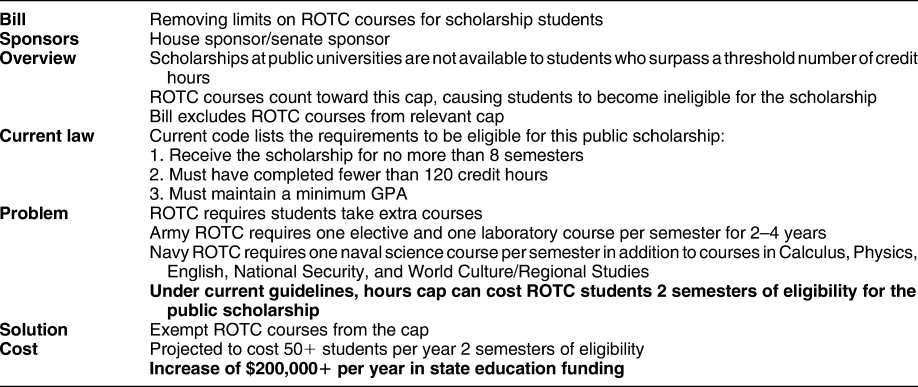
Information that readily identifies the state of interest has been removed.
Units
The unit of random assignment was the legislator–bill dyad. The first study included 76 legislators and 16 bills, and the second included 81 legislators and 16 bills, for a total of 2,512 observations. Over 75% of the legislature’s membership was included in the studies. The 32 bills represented nearly all veterans legislation sponsored during the two years.
Treatment Assignment
In each study, subject legislators were briefed on four of the sixteen eligible bills. Assignment procedures differed slightly across the two studies. The first study selected bills for treatment using block random assignment within legislator.Footnote 7 Treatment assignment was independent across legislators, which allowed multiple legislators in each office suite to be assigned to direct treatment for the same bill. This allows the estimation of combined briefing plus cue-taking treatment effects.
The second study featured three modifications to its assignment procedure. First, it included an additional treatment arm. Briefings were delivered either by the caucus staffer or by an advocate for a veterans’ interest group. To maintain parallelism between the studies (and because the advocate treatment appears to have been minimally effective; see Appendix A), advocate treatment effects are excluded from discussion in this paper.Footnote 8
Second, no legislator was assigned to treatment by both the caucus staffer and the advocate. Legislators were first assigned to either the caucus staffer, advocate, or pure control treatment condition, and then assigned to be briefed on four of the sixteen bills. This restriction was implemented to minimize the number of meetings and prevent legislators from connecting the activities of the advocate to the caucus. Compared to simple random assignment of units, this clustered random assignment reduces power.Footnote 9
Third, another restriction ensured that no two legislators in the same office were assigned to direct treatment for the same bill. Allowing interactions between direct and secondary treatment for two treatment arms would have yielded an unmanageable number of potential outcomes. This restriction ensures observations were assigned only to standalone direct or secondary treatment conditions. It increases the number of observations exposed only to the secondary caucus staffer treatment. At the same time, the restriction prevents any subject from being assigned to a combined treatment of briefing plus cue-taking.
Compliance
Both interventions featured high rates of compliance. In Study 1, 74 of the 76 legislators (97%) were briefed in-person. In Study 2, 25 of the 29 legislators (86%) assigned to the staffer treatment were briefed.Footnote 10 Due to noncompliance, analyses below estimate intent-to-treat effects (ITTs). ITTs represent the average change in cosponsorship of assigning a unit to treatment and do not account for whether units actually received the treatment.
Outcomes
Cosponsorship is an important form of position-taking. It signals legislators’ policy priorities to audiences inside and outside of the legislature.Footnote 11 Agenda setters look to cosponsorship to determine the breadth of support for proposals (Harbridge Reference Harbridge2015; Kessler and Krehbiel Reference Kessler and Krehbiel1996). Constituents use cosponsorship to determine whether legislators share their policy interests and are advancing legislation. Legislators require information about bills before they are willing to support them (Gilligan and Krehbiel Reference Gilligan and Krehbiel1987; Peress Reference Peress2013). Briefings relax these information constraints and, as a result, may promote cosponsorship by reducing legislators’ uncertainty.
Cosponsorship is a useful experimental measure of position-taking. Compared to roll call voting, party leaders typically do not pressure cosponsorship decisions (Lugar Reference Lugar2017). Cosponsorship is also largely unaffected by agenda control. Voting behavior depends on which bills reach a vote, but cosponsorship is possible for every bill as soon as it is filed. Cosponsorship thus measures legislators’ relatively unfiltered individual policy priorities.
Cue-taking is typically studied with respect to roll call voting. The rationale behind cue-taking is that it helps legislators make decisions when they are required to do so. Matthews and Stimson (Reference Matthews and Stimson1975) state that “When a member is confronted with the necessity of casting a roll call vote on a complex issue about which he knows very little, he searches for cues provided by trusted colleagues…” (45; emphasis added). Unlike voting, cosponsorship is not strictly necessary. Cosponsorship is not required by chamber rules, nor does it formally determine whether bills advance to become law. Further, failing to cosponsor a bill is not the same as opposing it. Legislators could simply avoid cosponsorship entirely.
The extent to which legislators take cues on cosponsorship and voting decisions is an empirical question, but it seems that the two decisions are more alike than they are different. Cosponsorship is present in legislatures and parliaments around the world. Cosponsorship and voting are both rational, instrumental actions meant to achieve legislators’ goals. Both appear motivated by legislators’ political ideology (Alemán et al. Reference Alemán, Calvo, Jones and Kaplan2009). Cosponsorship has become a common way for legislators to signal their policy priorities to constituents, such that a legislator who cosponsors nothing may be viewed as failing to advance constituents’ interests. Further, opting out of cosponsorship obviates the possibility of supporting a bad bill, but it also removes the benefits from associating with a good bill. A legislator who refuses to cosponsor bills is passing up a valuable form of position-taking and credit claiming. It is not enough for legislators not to cosponsor the wrong bills; they need to cosponsor the right bills too, and this is where the information problem bites.
Spillover Model
Contagion is modeled between legislators who share office suites. Due to space constraints in the legislative office building, 68 of the 76 legislators in Study 1 and 62 of the 81 legislators in Study 2 shared office suites. Assignment to offices is not random, and legislators frequently maneuver to occupy suites with friends. Legislators in one-person offices are dropped, as they cannot be assigned to secondary treatment, leaving 2,080 legislator–bill observations.Footnote 12 Because there are two- and three-person suites in the capitol, probabilities of assignment to secondary treatment vary. Inverse probability weights account for these differences (Gerber and Green Reference Gerber and Green2012). Further, legislators in three-person suites could be exposed to spillover through both suitemates. Due to the small number of such observations, they are not displayed.Footnote 13
Results
Table 3 displays weighted average cosponsorship rates by direct and secondary treatment assignment, with the number of observations in each condition in parentheses. Columns indicate assignment to cue-taking and rows indicate assignment to briefings. The untreated cosponsorship rate is 10.4%. Cosponsorship rates are higher among all three treatment conditions than in the control condition.
TABLE 3. Summary of Cosponsorship by Briefing and Cue-Taking Assignment (in pp)
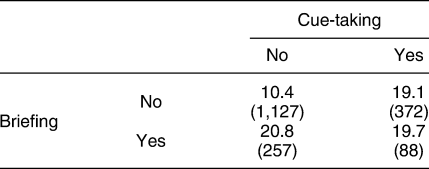
Observations assigned to the advocate (200) or multiple caucus spillover treatments (36) are omitted.
To account for imbalance in the profile of bills assigned to treatment in the second study,Footnote 14 treatment effects are estimated with weighted least squares regression with bill- and legislator-specific fixed effects:
 $$\eqalign{ {Y_{ib}} \!= \,& {\beta _0} + {\beta _1}d_{ib}^{10} + {\beta _2}d_{ib}^{01} + {\beta _3}d_{ib}^{11} \cr & + {\gamma _1}{\rm{Bill}}\;{1_b} + {\gamma _2}{\rm{Bill}}\;{2_b} + \cdots + {\gamma _{B - 1}}{\rm{Bill}}\;B - {1_b} \cr & + {\delta _1}{\rm{Leg}}\;{1_i} + {\delta _2}{\rm{Leg}}\;{2_i} + \cdots + {\delta _{I - 1}}{\rm{Leg}}\;I - {1_i} + {u_{ib}}, \cr}$$
$$\eqalign{ {Y_{ib}} \!= \,& {\beta _0} + {\beta _1}d_{ib}^{10} + {\beta _2}d_{ib}^{01} + {\beta _3}d_{ib}^{11} \cr & + {\gamma _1}{\rm{Bill}}\;{1_b} + {\gamma _2}{\rm{Bill}}\;{2_b} + \cdots + {\gamma _{B - 1}}{\rm{Bill}}\;B - {1_b} \cr & + {\delta _1}{\rm{Leg}}\;{1_i} + {\delta _2}{\rm{Leg}}\;{2_i} + \cdots + {\delta _{I - 1}}{\rm{Leg}}\;I - {1_i} + {u_{ib}}, \cr}$$where Y ib indicates cosponsorship by legislator i on bill b; the three indicator variables ![]() $d_{ib}^{i\neg i}$ indicate ego and alter treatment assignment for legislator i and bill b, and u ib represents unmeasured determinants of cosponsorship. Bill and legislator-specific indicator variables account for varying baseline levels of cosponsorship.
$d_{ib}^{i\neg i}$ indicate ego and alter treatment assignment for legislator i and bill b, and u ib represents unmeasured determinants of cosponsorship. Bill and legislator-specific indicator variables account for varying baseline levels of cosponsorship. ![]() $d_{ib}^{10}$ represents legislators assigned only to briefings;
$d_{ib}^{10}$ represents legislators assigned only to briefings; ![]() $d_{ib}^{01}$ legislators assigned only to cues; and
$d_{ib}^{01}$ legislators assigned only to cues; and ![]() $d_{ib}^{11}$ legislators assigned to the combined briefing and cue treatment. The key parameters of interest are β 1, β 2, and β 3, the average intent-to-treat effects of briefings, cues, and combined treatments. Standard errors and p-values are obtained through randomization inference. Ten thousand simulated treatment assignments are used to obtain simulated treatment effects under the sharp null hypothesis of no treatment effect for any unit.
$d_{ib}^{11}$ legislators assigned to the combined briefing and cue treatment. The key parameters of interest are β 1, β 2, and β 3, the average intent-to-treat effects of briefings, cues, and combined treatments. Standard errors and p-values are obtained through randomization inference. Ten thousand simulated treatment assignments are used to obtain simulated treatment effects under the sharp null hypothesis of no treatment effect for any unit.
Table 4 presents estimated treatment effects. Estimates are positive, substantial in magnitude, and unlikely to have occurred by chance under the sharp null. Estimated briefing effects are 4.5 percentage points (p < 0.05 one-sided), and estimated cue-taking effects 3.5 percentage points (p < 0.05 one-sided). These estimates are large relative to the 10% baseline rate of cosponsorship.
TABLE 4. Estimated Briefing and Cue-Taking Effects (in pp)
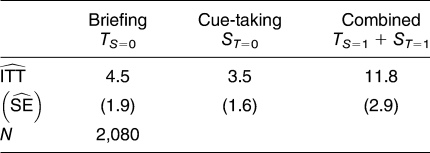
Standard errors and p-values obtained using randomization inference and 10,000 simulated assignments.
Observations assigned to advocate direct or secondary treatment (200) or multiple staffer secondary treatments (36) are not displayed.
The estimated contagion rate α is a considerable 79%. Subjects indirectly exposed to information exhibit treatment effects nearly 80% as large as subjects directly exposed to treatment. Put another way, for every ten cosponsorships caused by briefings, another eight resulted from cue-taking.
The combined effects of briefings and cue-taking are 11.8 percentage points (p < 0.001 one-sided). To determine whether combined effects are significantly larger than the sum of standalone briefing and cue-taking effects, 10,000 simulations were conducted under the null hypothesis that treatment effects equaled their observed values.Footnote 15 In only 8.0% of simulations were the sum of briefing and cue-taking effects larger than the estimated 11.8 percentage point combined effect from the observed experiment.
These results are instructive in several respects. First, information is highly influential whether it reaches legislators directly or second-hand. Information constraints appear to be binding on many decisions. Second, information diffuses widely within legislatures. Contagion rates within legislative offices are even larger than contagion rates within households (Foos and de Rooij Reference Foos and de Rooij2017; Nickerson Reference Nickerson2008). Third, briefings and cues are complementary. Legislators are responsive to repeated information treatments. Fourth, ignoring contagion can exaggerate or attenuate direct treatment effects on a case by case basis. Estimated direct treatment effects (4.5pp) are smaller than estimated effects when spillover is ignored (5.2pp). The often-default position to assume interference attenuates estimated effects need not always be correct.Footnote 16
THE DEMAND FOR CUES
Studying cue-taking through this treatment-contagion framework assumes that the baseline supply of cues is constrained. Uninformed legislators cannot, or at least will be more hesitant to, provide guidance on legislation. Briefings increase the supply of available cues by increasing the number of informed legislators. But what of the demand for cues? What factors determine whether legislators will seek out guidance?
Matthews and Stimson and Kingdon describe cue-taking as a strategy borne of necessity. Legislators seek out guidance when they are required to pass judgment on legislation. They will not spend their scarce time learning about legislation that is likely to fail early in the policymaking process. The demand for cues, then, will be greatest when a bill reaches a floor vote where all members are required to judge it. To what extent do we observe cue-taking as a phenomenon driven by floor consideration of legislation? Are cue-taking effects larger for bills that reached the floor than bills that failed in committee?
Bills reached the floor after treatments were delivered, so there is the potential for post-treatment bias (Gelman and Hill Reference Gelman and Hill2006). However, there are reasons to think that bill progress is independent of briefing and cue-taking treatments. Treatment was assigned at the dyad, not bill, level, so all bills were assigned to treatment for some legislators. Further, most observations were assigned to the control condition. Three-fourths of observations in Study 1 and over four-fifths in Study 2 were assigned to the control group. So, despite large effects of treatment on individual cosponsorship, aggregate effects are likely modest.
Table 5 presents results from equation (1) fit separately for the 17 bills that failed prior to reaching the floor and the 15 bills that reached the floor. Regression yields conditional average treatment effects (CATEs) based on bill progress. CATEs are estimated treatment effects among subsets of the population; they are not causal estimates of bill progress on cosponsorship.Footnote 17
TABLE 5. Estimated Briefing and Cue-Taking Effects by Bill Progress (in pp)
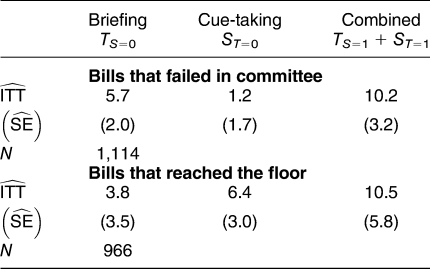
Standard errors and p-values obtained using randomization inference and 10,000 simulated assignments.
Observations assigned to advocate direct or secondary treatment (200) or multiple staffer secondary treatments (36) are not displayed.
Briefings generated large positive direct and combined effects regardless of whether bills reached a vote. In fact, estimated briefing effects are larger for bills that failed in committee (5.7 percentage points) than bills that reached the floor (3.8 percentage points). This pattern does not suggest that bills that reached the floor were somehow higher quality or more appealing to legislators than bills that failed in committee.
Cue-taking appears more influential for bills that reached the floor. Estimated cue-taking effects for bills that fail in committee are close to zero (1.2 percentage points), but estimated effects for bills that reach the floor are substantial in magnitude (6.4 percentage points). Simulations under the sharp null hypothesis of no effect for any legislator yield such large differences in cue-taking between bills that reach the floor and those that do not only 6.8% of the time.
Bills that reach a vote might differ from those that fail in committee in ways that make them more susceptible to cue-taking. Perhaps they are higher quality or more ideologically appealing to members of the majority party. So we look for demand-driven cue-taking in a second manner: using the dates of cosponsorship.
In this legislature, cosponsorship dates are not posted publicly. However, cosponsorship slips include a space for cosponsors, or the bill sponsor asking for their support, to list the date on which the legislator agreed to cosponsor the bill. Original cosponsorship slips are preserved in the official record of the house clerk. We searched through these records and were able to find cosponsorship dates for 275 of the 281 cosponsorships in multi-person suites.
We examine whether cue-taking occurs late in the legislative session by running equation (1) on a redefined dependent variable. Instead of looking at whether a cosponsorship occurs by a legislator for a given bill, we examine whether a cosponsorship occurs by a legislator for a given bill by a certain date. Rather than arbitrarily choosing one date to indicate early or late cosponsorship, equation (1) is estimated for different time intervals during the session. Treatment effects are estimated for windows beginning from the start of the session and proceeding by one week increments until the end of the session, three and a half months after the sessions began. Each interval indicates whether a cosponsorship occurred from the beginning of the session until the interval’s end date.Footnote 18
In both experiments, briefings occurred five to eight weeks after the sessions began. The reason for this delay is that the legislature has a bill filing deadline scheduled four weeks after session begins. Bills were included in the study, and research reports drafted, only after the bill filing deadline passed. As in most state legislatures, the volume of bills that reach the floor for a vote increases throughout the session and reaches a peak right before adjournment.
Figure 3 shows estimated effects of briefings on cosponsorship throughout the legislative session. Estimates are small, and indistinguishable from zero, through the first four weeks, as no briefings had been held. Briefing effects rise from zero to three percentage points by week nine of the session, after all briefings had been held. Direct effects rise by another 1.5 percentage points during the six weeks after briefings were concluded.

FIGURE 3. Briefing Effects by Date of Cosponsorship
Figure 4 shows estimated effects of cue-taking over time. Again, estimates are small, and indistinguishable from zero, through the first four weeks. Cue-taking effects rise little during the month briefings were held. Through week nine, cue-taking effects are smaller than one percentage point. The bulk of cue-taking effects occur after briefings occurred, mostly in the final four weeks of the session.Footnote 19 Most cue-taking occurs late in the policymaking process, consistent with findings from Kingdon (Reference Kingdon1973) and Matthews and Stimson (Reference Kingdon1975).

FIGURE 4. Cue-Taking Effects by Date of Cosponsorship
Treatment may diffuse via cue-taking by several mechanisms. Cues’ effects may result from detailed discussions about policy between cue-giver and cue-taker, recommendations made in passing that “this is a good bill,” or even by behavior like cosponsorship by which the cue-giver unwittingly influences cue-takers. It is generally difficult to observe mechanisms in randomized experiments, and that is also true of studies of cue-taking. Even if it were possible to measure the exhaustive number of interactions between cue-givers and cue-takers (or to simply ask subjects how they learned about a bill), mediation analyses are fraught with challenges (Bullock, Green, and Ha Reference Bullock, Green and Ha2010).Footnote 20
The timing of briefing and cue-taking effects do suggest that some mechanisms are more likely than others. Legislators did not immediately leave briefings and cosponsor legislation. They waited for several weeks before cosponsoring bills. Cue-takers waited even longer to cosponsor bills. It thus does not appear that cue-givers solicited peers for their support at the same time they were deciding to cosponsor legislation. Cue-takers appeared to seek out information or observe the cosponsorship decisions of their cue-givers once bills reached the floor. Cue-givers received and processed information and then shared policy evaluations with cue-takers. It appears cue-givers did not simply hand over the policy briefings they received from the staffer. The policy information, decoupled from the briefings, seems to have spread between legislators.
ALTERNATIVE SPILLOVER MODELS
The focus of this paper is cue-taking within legislative offices. However, legislators may engage in cue-taking in other ways. They may look to legislators other than their officemates for advice. Is there evidence for alternative models of spillover across legislators?
Prior work asks whether legislators share information with their deskmates on the chamber floor (Masket Reference Masket2008), peers from neighboring districts (Bogue and Marlaire Reference Bogue and Marlaire1975), or ideologically-similar peers (Coppock Reference Coppock2014). Table 6 displays estimated briefing and cue-taking effects for alternative spillover models based on each of these relationships.Footnote 21 Cue-taking is estimated separately for each type of relationship using equation (1). Regressions use the same subset of data in which each subject was eligible for spillover from an officemate, deskmate, neighboring representative, or ideological peer.Footnote 22 This leaves 1,760 observations, compared to the 2,080 observations in the main analysis of office contagion.
TABLE 6. Estimated Briefing and Cue-Taking Effects Under Alternate Spillover Models (in pp)

Standard errors and p-values obtained using randomization inference and 1,000 simulated assignments.
Interest group treatment and multiple indirect treatment conditions omitted. Weights equal to inverse of probability of treatment assignment. Covariates include bill and legislator indicator variables.
Estimated direct effects are positive in each model, ranging from 2.9 to 5.8 percentage points. We would not expect changing the contagion model to significantly affect estimates of direct treatment. Estimated secondary effects are also positive in each model, but estimated effects are largest in the office model (3.7 percentage points), followed by district proximity (3.6), ideology (2.3), and desk (2.3) models. Effects are estimated less precisely for the alternative models, so estimates fall short of conventional levels of statistical significance.
Estimated standard errors for cue-taking and combined treatments under the alternative models are 20%–50% larger than standard errors under the office model. The difference in standard errors illustrates a benefit of defining the contagion network during the design stage of the research process. Restricting treatment assignment within offices increased the number of observations in the office spillover condition compared to the desk, district, or ideology spillover conditions.Footnote 23 Ex post contagion analyses are less powerful than experiments designed ex ante to study a particular form of contagion.
These alternative models of cue-taking do not find convincing support in the data, at least at conventional levels of statistical significance. The main takeaway from this analysis is not, and should not be, that these alternative models are wrong, either in this legislature or others. Rather, the results show just how hard it is to field an experiment that is powerful enough to detect treatment contagion effects. The experiments in this paper were designed specifically to estimate spillover across legislators in shared offices, and they are able to detect treatment effects of 3–4 percentage points. In contrast, spillover effects in networks defined ex post must be larger to be detected by experiments as large as these. Other forms of spillover are even more difficult to evaluate.Footnote 24 More studies, intentionally designed to estimate these cue-taking and contagion effects, are needed to adequately address alternative spillover networks.
DISCUSSION
Legislative scholars operate under the belief that communication and personal relationships are fundamental aspects of legislative life. At the same time, many quantitative analyses treat legislators as atomistic decision-makers whose preferences and behaviors are immune from outside influence. The results in this paper show that strong non-interference assumptions about legislative behavior, explicit in experiments but also implicit in many observational studies, are inappropriate in at least some contexts.
This paper takes up long-standing questions regarding cue-taking with a novel, causally-oriented research design. The large causal effects of cue-taking that legislators self-report—which researchers may have considered exaggerated or conflated with homophily—are supported by experimental evidence. Legislators describe cue-taking as a last-minute exercise, but data on the timing of cue-taking has heretofore been lacking. Cue-takers wait until bills reach the floor to seek out information from cue-givers. Cue-taking occurs on the timeline of the cue-taker, once they demand information, rather than of the cue-giver, once they become informed.
The experimental approach opens up new ways to study cue-taking. By jointly assigning cues and policy briefings to the same subject, we observed how cues complement briefings. Future studies can consider whether cues’ effects depend on endogenous information from lobbyists, advocates, or party leaders. Experiments can also be used to test whether some types of information lead to more cue-taking than others. Do legislators share political intelligence like polls or interest group positions more or less readily than technical information about proposals? Finally, experiments can be designed to manipulate the mechanisms by which legislators receive cues.
The experimental design excels with respect to identification, but it raises numerous external validity concerns. First, the intervention provided a specific type of information that may not be representative of legislators’ day-to-day discussions. Technical policy information may differ from political intelligence such as polling or the preferences of other politicians. Briefings were conducted by a staffer for a bipartisan caucus, a trusted and influential information source. The experiments included bills in an issue area with broad, bipartisan support. They are not representative of the broader legislative agenda.
Second, the contagion network in this legislature may not represent other networks. The network itself was not randomly assigned, so effects cannot be attributed solely to sharing an office. Observed effects may conflate office sharing with a different underlying causal pathway such as legislators’ friendships. Further, the degree of interoffice communication likely varies across offices and over time in ways that may affect the magnitude of cue-taking in other contexts.
Third, cosponsorship is an important position-taking behavior, but its relative low-cost may make it particularly well-suited to observing contagion. Roll call voting may be immune to interference because it is more directly consequential to policy outcomes or more closely monitored by party leaders. At the same time, the fact that party leaders pay more attention to roll call voting and devote time to whipping members suggests that roll call voting is also subject to interpersonal influence.
Fourth, two studies were conducted, but in the same legislature. Although this legislature shares many characteristics with other state legislatures, including its level of professionalization and one-party control, it may not represent other legislative contexts. Legislatures with more individual staff may exhibit less diffusion if legislators outsource information-gathering to aides. Conversely, diffusion may be stronger if aides collaborate across offices.
Fifth, this study relaxes interference across legislators but still assumes strict noninterference across bills. Information about one bill is assumed not to help legislators make decisions about other bills. The question of spillover across bills is addressed in Appendix B. There is little evidence that it occurs. Nevertheless, these studies did not set out to test spillover across bills, so the null findings may result from the lack of such spillover or from low power.
Each of these external validity concerns is an empirical question and an opportunity for further research (Nickerson Reference Nickerson2008). The magnitude of spillover effects found in this paper may not extend to other legislatures, issues, or treatments. The main contribution of this paper is to illustrate not just that the effects of treatment contagion can approach the magnitude of treatments’ direct effects, but that the large-scale experiments needed for studying contagion are possible in legislative contexts. The magnitude of cue-taking effects may vary, but the gains to power from considering contagion in experimental designs make contagion-based studies of cue-taking a viable research program.
If contagion occurs in other legislative experiments, then legislators may be even more responsive to informational interventions than is currently thought. Contagion might cause particularly large attenuation in estimated effects in block-randomized designs, since blocks contain like-minded legislators who might share information (Butler and Nickerson Reference Butler and Nickerson2011; Kalla and Broockman Reference Kalla and Broockman2015). That said, contagion may diminish or exaggerate treatment effects on a case-by-case basis.
Finally, cue-taking raises questions about the effects of homophily on legislative outcomes. Legislative networks are characterized by like-minded individuals associating with one another. For example, no legislator in this study shared an office with a member of the opposing party. If contagion occurs across homophilic networks, improving information may exacerbate rather than ameliorate divisions. Reforms to reduce polarization might want to encourage information-sharing between dissimilar peers, not strengthen cue-taking between like-minded legislators.
SUPPLEMENTARY MATERIAL
To view supplementary material for this article, please visit https://doi.org/10.1017/S0003055419000078.
Replication materials can be found on Dataverse at: https://doi.org/10.7910/DVN/ZJTLSW.


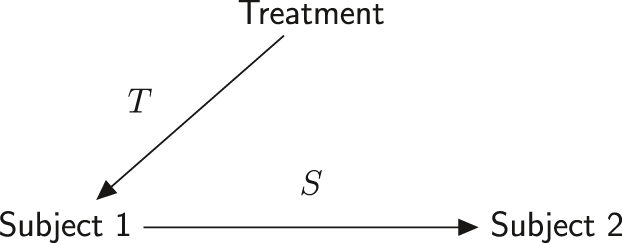
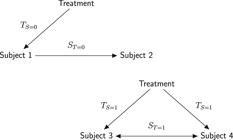

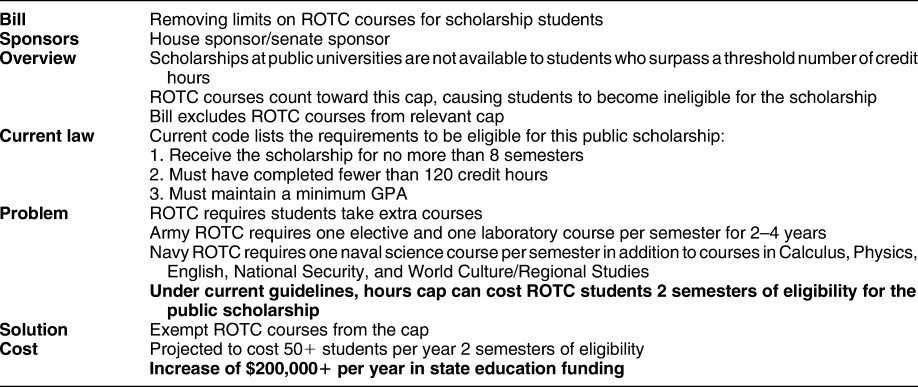
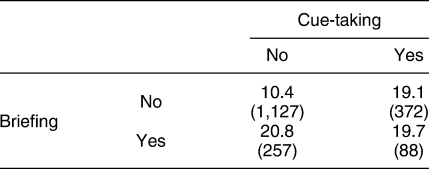


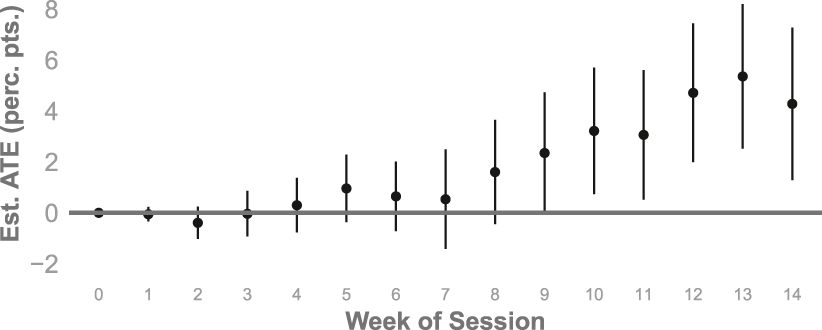
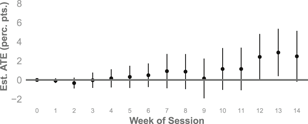


Comments
No Comments have been published for this article.